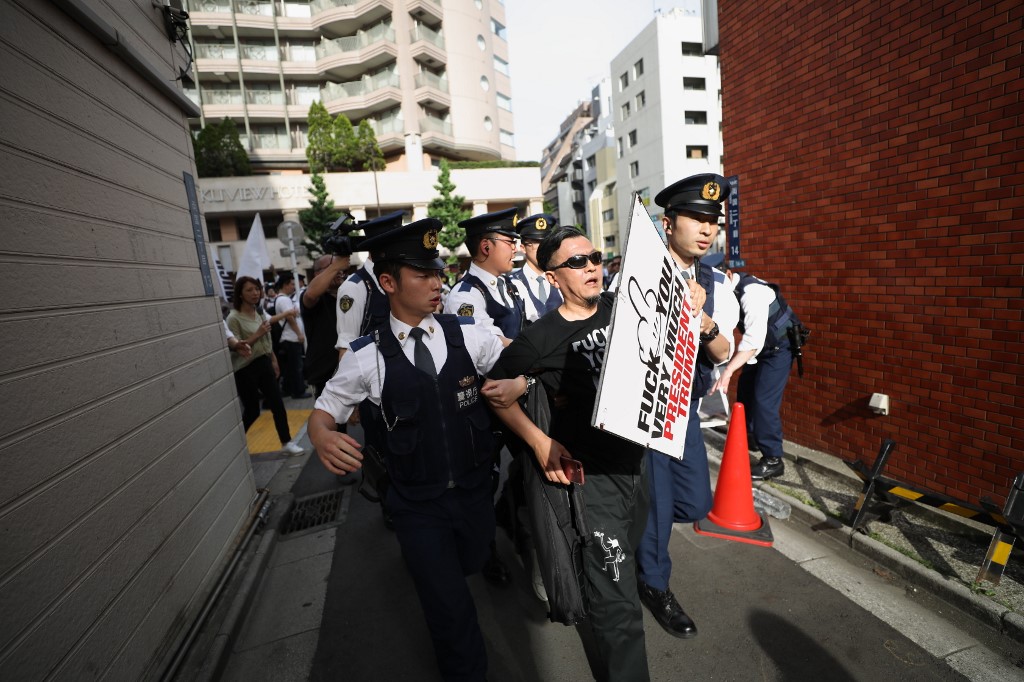Japanese sumo vs Trump’s WWE: big differences in clash of big men

Japanese policemen take a man, holding an anti-Trump slogan, away from the street around the Ryougoku Sumo Hall, where US President will visit, in Tokyo on May 26, 2019. (Photo by Behrouz MEHRI / AFP)
President Donald Trump will be ringside Sunday for Tokyo’s big sumo tournament, but if he hopes his longtime love of US-style professional wrestling will give him special insight into the action, he better think again.
Both sumo and the WWE involve enormous men wearing very little and trying to batter each other. Both are popular in their respective countries, drawing large excitable crowds.
Article continues after this advertisementBut that’s — almost — where similarities end.
WWE wrestlers are out more to entertain than to wrestle. While there is a winner and a loser, the combatants are following a choreographed script that ends in a pre-determined outcome.
Over the years of World Wrestling Entertainment extravaganzas, the likes of Stone Cold Steve Austin, Hulk Hogan and The Undertaker have stopped at nothing in pursuit of victory.
Article continues after this advertisementNot only fists and body slams are used, but also chairs, ladders, snakes and fire — that’s right, the ring was once set on fire.
However, all the action is rehearsed, then carefully meted out in a spectacle having more to do with theatre than sport. Done any other way, the televised bouts would quickly result in maimings and worse.
Sumo also showcases powerful, near-naked men in primal confrontation, surrounded by shouting crowds in packed arenas.
But these players are steeped in centuries-old Japanese traditions rooted in the Shinto religion, starting with the sipping of sacred water and the sprinkling of purifying salt before each bout.
While crowds love the intensity of the fight, the wrestlers show little emotion, whether in victory or defeat — a far cry from the screams and insults of the WWE ring.
In sumo, referees’ decisions can only be overturned by judges and the wrestler accepts the ruling. Even small gestures of dissent such as a tiny shake of the head could land a sumo wrestler in big trouble.
In the WWE? Referees’ decisions are not only challenged, but the referees themselves are frequently clobbered by the wrestlers.
‘Dominant champion’
Trump loves the razzmatazz, the lurid spectacle and the money of WWE. He once body-slammed and shaved the head of an American wrestling bigwig during a televised event.
And he has been inducted into the WWE’s Hall of Fame, not as a wrestler of course, but as a promoter and super fan.
Many trying to understand the Trump phenomenon have gone further, tracing his love of outrageous showmanship and all-or-nothing political style to the influence of pro-wrestling.
That’s not to say sumo is completely free from the WWE’s shadier practices, however.
The hermetic world of the loincloth-clad wrestlers has been rocked by allegations of drug abuse, bout-fixing and links to organised crime. The bullying death of an apprentice wrestler in 2007 plunged the sport into crisis.
And faux sumo matches have also been staged as part of WWE wrestling shows, with wrestlers such as Yokozuna (sumo term for Grand Champion) entertaining the crowd.
Described on the WWE website as “one of the most dominant WWE champions of all time”, the Samoan weighed nearly 600 pounds (272 kilogrammes) but never actually competed in a sumo basho, or tournament.